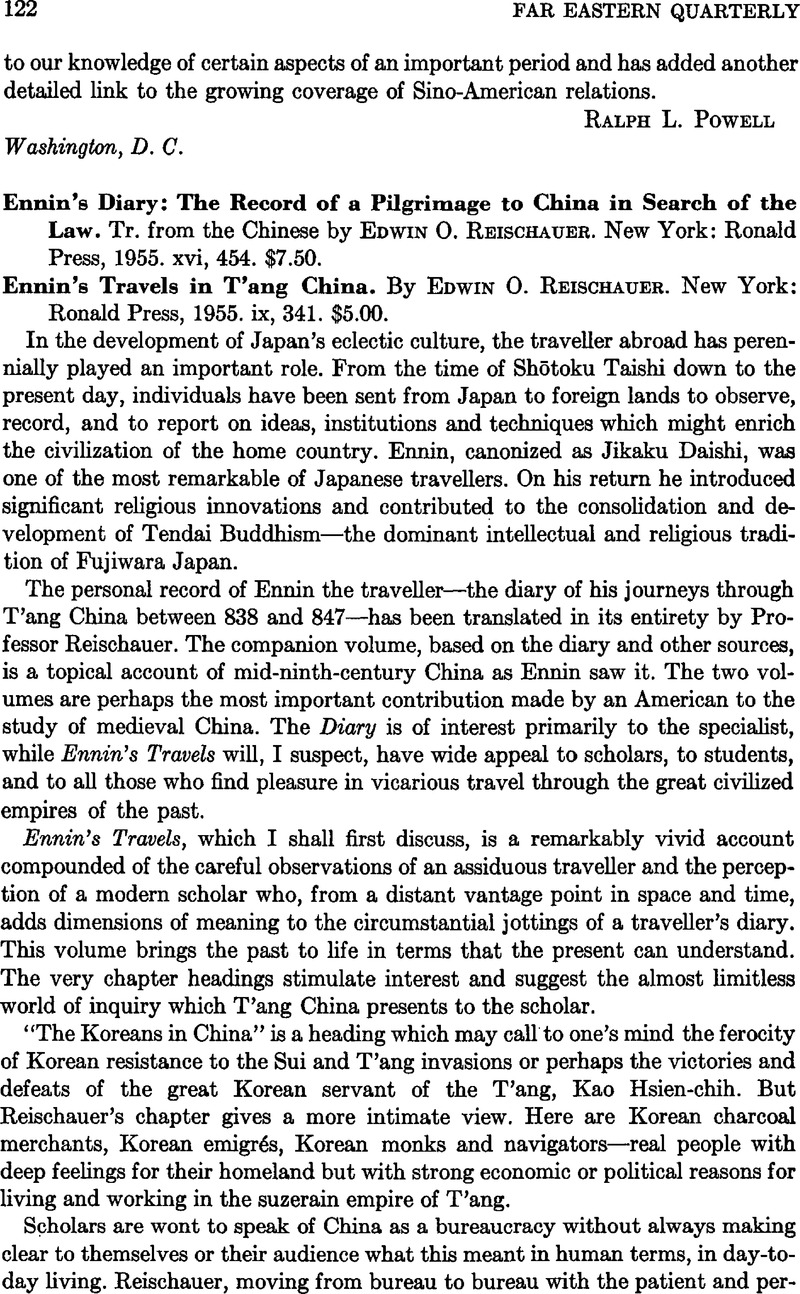No CrossRef data available.
Article contents
Ennin's Diary: The Record of a Pilgrimage to China in Search of the Law. Tr. from the Chinese by Edwin O. Reischauer. New York: Ronald Press, 1955. xvi, 454. $7.50. - Ennin's Travels in T'ang China. By Edwin O. Reischauer. New York: Ronald Press, 1955. ix, 341. $5.00.
Review products
Published online by Cambridge University Press: 23 March 2011
Abstract

- Type
- Book Reviews
- Information
- Copyright
- Copyright © The Association for Asian Studies, Inc. 1955
References
1 Account might have been taken, for example, of de Groot's two studies of the edict and the persecution, one in Archiv für Religionswissenschaft (1904), 157–168Google Scholar, the other in his Sectarianism and Religious Persecution in China (1903), 64–67Google Scholar. Von Zach's corrections to de Groot's translation are helpful, though not free of mistakes. Lexicographische Beitrāge (Peking, 1904), 2:42–44Google Scholar. A much improved annotated translation appears in Chavannes and Pelliot, Un traité Manichéen retrouvé en Chine (Paris, 1913), 2:296fGoogle Scholar. A later translation—making little if any use of the earlier ones—is that of Ying Ch'ien-li in the Bulletin of the Catholic University of Peking, 6 (1929), 120–123Google Scholar. Portions of this, with corrections, appear in Goodrich, L. C., A Short History of the Chinese People (New York, 1943), 125–127Google Scholar. The discussion, partial translation, and notes of Otto Franke are useful. Cf. Geschichte des Chinesischen Retches (Berlin, 1936), 2:494–499Google Scholar and (Berlin, 1937), 3:415–417.
2 Cf., for example, Lévi and Chavannes, JA, (1916), 193–194Google Scholar, Pelliot, TP, 24 (1927), 92–94Google Scholar and TP, 26 (1929), 51–52Google Scholar. In this last note Pelliot reiterates the equivalence of hsiangchiao and Skt. pratirūpaka-dharma, “Loi contrefaite,” though he concedes that a different but related meaning, namely “image religion”—the religion which grew up when images replaced living masters—appeared in China at least as early as the Sung. In no case, however, could the term be rendered pejoratively as “idolatrous religion.”
3 My point of view is close to that which Legge expressed in discussing the difficulty of translating the I-ching, though I would use different terminology. “How to surmount the difficulty occurred to me after I had found the clue to the interpretation;—in a fact which I had unconsciously acted on in all my translations of other classics, namely, that the written characters of the Chinese are not representations of words, but symbols of ideas, and that the combination of them in composition is not a representation of what the writer would say, but of what he thinks. It is vain therefore for a translator to attempt a literal version.” Yi King (SBE XVI) (Oxford, 1882)Google Scholar, Preface, p. xv.


